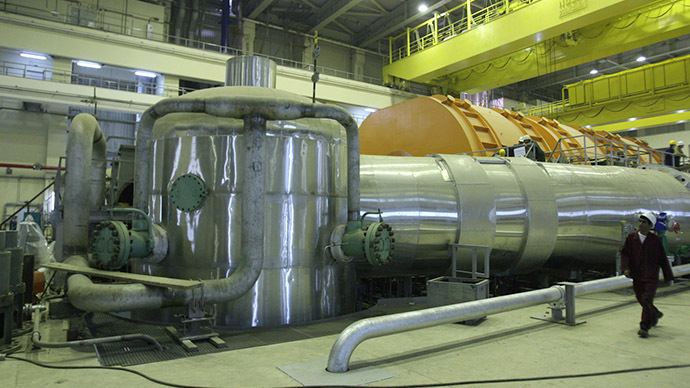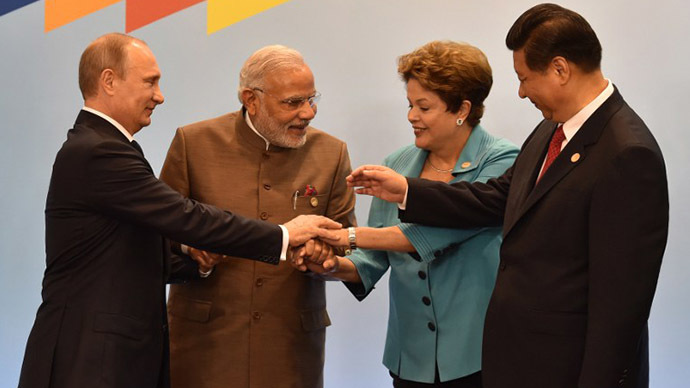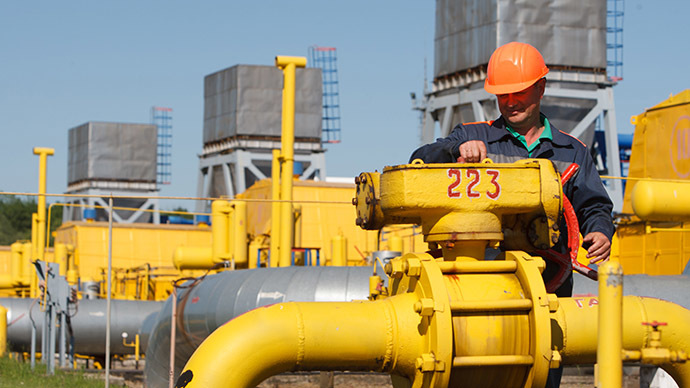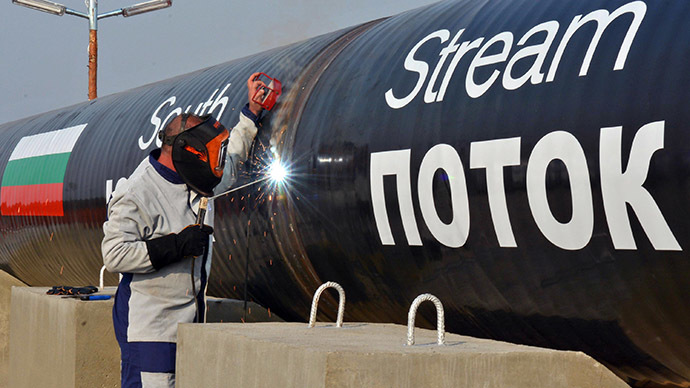Energy ballet: Iran, Russia and 'Pipelineistan'

A fascinating nuclear/energy ballet involving Iran, Russia, the US and the EU is bound to determine much of what happens next in the new great game in Eurasia.
Let’s start with what’s going on with the Iranian nuclear dossier.
Iranian Foreign Ministry legal adviser Jamshid Momtaz has been forced to clarify that the interim nuclear deal signed by Iran and the P-5+1 nations on November 2013 is not an international treaty – yet.
As we stand, the gap between the US, Russia, China, Britain, France and Germany on one side, and Iran on the other side, remains very wide. Essentially, the gap that really matters is between Washington and Tehran. And that, unfortunately, translates as a few more months for the vast sabotage brigade – from US neo-cons and assorted warmongers to Israel and the House of Saud – to force the deal to collapse.
One of Washington’s sabotage mantras is “breakout capability”; a dodgy concept which boils down to total centrifuge capacity/capability to produce enough enriched uranium for a single nuclear bomb. This implies an arbitrary limit on Iran’s capacity to enrich uranium.
The other sabotage mantra forces Iran to shut down the whole of its uranium enrichment program, and on top of it negotiate on its missiles. That’s preposterous; missiles are part of conventional armed forces. Washington in this instance is changing the subject to missiles that might carry the nuclear warheads that Iran does not have. So they should also be banned.
Moscow and Beijing see “breakout capability” for what it is; a manufactured issue. While Washington says it wants a deal, Moscow and Beijing do want a deal – stressing it can be respected via strict monitoring.

Iranian Supreme Leader Ayatollah Khamenei has established his red line on the record, so there should be no misunderstanding; the final nuclear deal must preserve Tehran’s legitimate right to enrich uranium - on an industrial scale – as part of a long-term energy policy. This is what Iranian negotiators have been saying from the beginning. So shutting down uranium enrichment is a non-starter.
Sanction me baby one more time
Uranium enrichment, predictably, is the key to the riddle. As it stands, Tehran now has more than 19,000 installed enrichment centrifuges. Washington wants it reduced to a few thousand. Needless to add, Israel – which has over 200 nuclear warheads and the missiles to bomb Iran, the whole thing acquired through espionage and illegal arms deals – presses for zero enrichment.
In parallel undercurrents, we still have the usual US/Israeli “experts” predicting that Iran can produce a bomb in two to three months while blasting Tehran for “roadblocks” defending its “illicit” nuclear program. At least US National Security Adviser Susan Rice has momentarily shut up.
Another key contention point is the Arak heavy-water research reactor. Washington wants it scrapped – or converted into a light-water plant. Tehran refuses, arguing the reactor would only produce isotopes for medicine and agriculture.
And then there’s the sanctions hysteria. The UN and the US have been surfing a sanction tidal wave since 2006. Tehran initially wanted those heavy sanctions which amount to economic war lifted as soon as possible; then it settled for a progressive approach. Obama might be able to lift some sanctions – but a US Congress remote-controlled by Tel Aviv will try to keep others for eternity.
Here, with plenty of caveats is a somewhat detailed defense of a good deal compared to what may lead towards an apocalyptic road to war.
Assuming there is a deal, a crucial point is how long it will last. Washington wants it to be two decades. Tehran wants five years – and then it should be treated like any other signatory to the 189-nation Nuclear Non-Proliferation Treaty (NPT) - which allows non-nuclear weapons states to develop nuclear energy for civilian purposes. For an enlightened Iranian perspective, see here.
It’s a tragicomedy, really. Washington plays The Great Pretender, faking it full-time that Israel is not a nuclear-armed power while trying to convince the whole planet Israel is entitled to amass as many weapons as it wants while Iran is not allowed to even have conventional means to defend itself. Not to mention that nuclear-armed Israel has threatened and invaded virtually all of its neighbors, while Iran has invaded nothing.
Dance to the energy ballet
As harsh as they really are, sanctions did not force Tehran to kneel and submit. Khamenei has repeatedly said he’s not optimistic about a nuclear deal. What he really wants, much more than a deal, is an improved economy. Now, with the sanctions cracking after the initial Geneva agreement, there is light at the end of the tunnel.
Enter turbo-charged Russia-Iran negotiations. They include a power deal worth up to $10 billion, including new thermal and hydroelectric plants and a transmission network.
And of course the oil-for-goods swap according to which Russia may buy 500,000 barrels of Iranian oil a day. Details are to be finalized in early September. No wonder Washington is fuming; this deal should propel Iran’s oil exports over one million barrels a day, something that was initially agreed upon in Geneva.
With Russia now also under US and EU sanctions, predictably Tehran had to start openly courting Europe as the ideal alternative source of natural gas. I have been writing about this for years now. Europe is desperate to diversify from Gazprom. Iran has all it takes to sell gas to Europe transiting especially via Turkey. Yet there are so many political and logistical roadblocks – starting with the necessity of a final nuclear deal – which this is an extremely long-term scenario at best.

The energy ballet involving Iran, Russia, the EU and the US is worthy of a geopolitical neo-Stravinsky. Tehran is careful not to antagonize Moscow – the largest supplier of natural gas to Europe. But Tehran also knows that with US-Iran possibly entering a détente, the EU will go for broke to seduce and invest in Iran.
Iranian Deputy Oil Minister for International and Trade Affairs Ali Majedi definitely has seen which way the wind is blowing. He is already talking about three different routes Tehran could use for its energy exports to the West.
According to the BP Statistical Review of World Energy, Iran’s proven natural gas reserves are at a whopping 33.6 trillion cubic meters, while Russia's are at 32.9 trillion cubic meters. Talk about two powerhouses.
The problem is Iran is way behind Russia in investment and production. A few years ago, in Tehran, energy experts measured it for me at $200 billion needed to upgrade the industry and invest in domestic transport and export infrastructure.
So, realistically, Russia will remain the key gas supplier to the EU in the foreseeable future, predominating over the strategic value of Iranian and Central Asian gas. And that includes the fact that plenty of EU nations, despite non-stop political shenanigans in Brussels, support the construction of the Russia-favored South Stream pipeline.
Tehran, though, is now in the game - already attracting a host of prospective, powerful foreign investors from Europe and Asia. A recent international oil, gas, refining and petrochemicals exhibition in Tehran attracted no less than 600 foreign companies from 32 countries.
We got it all covered
Iranian Deputy Foreign Minister Majid Takht Ravanchi – part of the nuclear negotiating team – has been positively ecstatic lately; “Naturally Iran and Europe could have much better cooperation on the economy, trade, and energy. We believe there is much room for improvement.”
But it was Iran’s Deputy Oil Minister Ali Mejidi who went a colossal step further – resuscitating the moribund Nabucco pipeline; “With Nabucco, Iran can provide Europe with gas. We are the best alternative to Russia.”
Nabucco, a “Pipelineistan” saga I have followed in detail, was all about a pipeline to Europe via Turkey, Bulgaria, Romania, Hungary and Austria filled with sometimes Azerbaijani, sometimes Iraqi gas, before it spectacularly floundered for lack of investment.
Does that mean Iran is picking an energy war with Russia? Not really. Nabucco is a major, expensive “if”, and extremely long-term. South Stream, although momentarily stalled, is ready to go.

What happened in the shadows is that Washington let it be known to Tehran that if the $10 billion Iran-Iraq-Syria gas pipeline was dropped, the sanctions would be somewhat relaxed, and Iran could have the go-ahead to revive Nabucco, a US-supported European obsession and formerly fierce rival of South Stream.
Yet talk is cheap. As it stands, there is a larger probability of Iran-Iraq-Syria finding financing within the next two to three years than Nabucco.
In parallel, as much as the US and EU sanctions on Russia are strengthening Iran in the nuclear talks, especially towards the Europeans, this does not mean Tehran will overplay the Russia card. As much as Iranian negotiators are relishing the new plot twist, the overall Iranian policy is in fact closer bilateral ties with Moscow to crack those sanctions on Iran for good.
And if Washington decides to keep the sanctions forever, Plan B is at hand: even closer Iranian cooperation with both Russia and China. Not accidently Iranian President Rouhani has dismissed any alarm about Iran-Russia relations; “Strong political ties in bilateral, regional and international domains, along with vast economic relations between the two countries, set the stage for the promotion of peace and stability.” This includes everything from the Bank of China’s parallel system to pay for Iranian energy to Iran-Russia barter deals.
In many overlapping ways, the Iranian nuclear dossier now is like a hall of mirrors. It reflects an unstated Washington dream; unfettered access for US corporations to a virgin market of 77 million, including a well- educated young urban population, plus an energy bonanza for US Big Oil.
But in the hall of mirrors there’s also the Iranian projection – as in fulfilling its destiny as the top geopolitical power in Southwest Asia, the ultimate crossroads between East and West.
So in a sense the Supreme Leader has it all covered. If Rouhani shines and there is a final nuclear deal, the economic scenario will vastly improve, especially via massive European investment. If Washington scotches the deal over pressure from the usual lobbies, Tehran can always say it exercised all of its “heroic flexibility,” and move on – as in closer and closer integration with both Russia and China.
The statements, views and opinions expressed in this column are solely those of the author and do not necessarily represent those of RT.
The statements, views and opinions expressed in this column are solely those of the author and do not necessarily represent those of RT.













